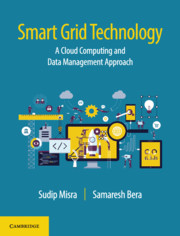Book contents
- Frontmatter
- dedication
- Contents
- Figures
- Tables
- Foreword
- Preface
- Part I Introduction
- Part II Cloud Computing Applications for Smart Grid
- 5 Demand Response
- 6 Geographical Load-Balancing
- 7 Dynamic Pricing
- 8 Virtual Power Plant
- 9 Advanced Metering Infrastructure
- 10 Cloud-Based Security and Privacy
- Part III Smart Grid Data Management and Applications
- Part IV Smart Grid Design and Deployment
- Index
5 - Demand Response
from Part II - Cloud Computing Applications for Smart Grid
Published online by Cambridge University Press: 20 October 2018
- Frontmatter
- dedication
- Contents
- Figures
- Tables
- Foreword
- Preface
- Part I Introduction
- Part II Cloud Computing Applications for Smart Grid
- 5 Demand Response
- 6 Geographical Load-Balancing
- 7 Dynamic Pricing
- 8 Virtual Power Plant
- 9 Advanced Metering Infrastructure
- 10 Cloud-Based Security and Privacy
- Part III Smart Grid Data Management and Applications
- Part IV Smart Grid Design and Deployment
- Index
Summary
Typically, in traditional power delivery systems, energy is supplied to the customers using non-renewable energy sources. Therefore, the energy generators are based on fossil fuels. Consequently, carbon emission in the environment is very high, and there is potentially a great impact on the environment. In contrast, in the smart grid system, energy is supplied to the end-users using renewable and non-renewable energy sources. Additionally, the implementation of distributed energy sources plays an important role for real-time energy management in the smart grid. Consequently, in the presence of distributed energy sources at the customers’ end, electricity consumers can schedule their shiftable appliances to the off-peak hours to relieve the extra load on the grid during on-peak hours. This mechanism is widely known as demand response (DR). The objective of any demand response mechanism is to reduce energy consumption cost to the customers and reduce imbalance between the energy supply and demand, while modifying the energy consumption pattern according to real-time price signals.
Fundamentals of Demand Response and Challenges
Different technologies are introduced in a smart grid system in order to establish the demand response mechanism – demand scheduling, online energy monitoring, and deployment of distributed energy sources. As mentioned earlier, customers can schedule their shiftable appliances to off-peak hours so as to minimize their energy consumption cost. Additionally, the real-time energy demand to the grid can also be relieved during peak hours. In the traditional power delivery system, such strategies cannot be deployed by the service providers in order to schedule the customers’ energy demand. Therefore, we have on-peak and off-peak hours in which energy demand is more and less, respectively, than the energy supply to the grid. On the other hand, using the demand response mechanism, the energy demand from the customers can be modified according to the energy supply to the grid in order to minimize the imbalance between the energy supply and the demand to the grid. However, there are several challenges that should be considered in order to install demand response mechanisms in real-life environments.
1. Peak load reduction: In the smart grid, there are three different time-slots depending on the energy load on the grid – on-peak, mid-peak, and off-peak. During on-peak hours, energy demand from the customers is high. On the other hand, during mid-peak and off-peak hours, demands from the customers are moderate and low, respectively.
- Type
- Chapter
- Information
- Smart Grid TechnologyA Cloud Computing and Data Management Approach, pp. 61 - 80Publisher: Cambridge University PressPrint publication year: 2018

